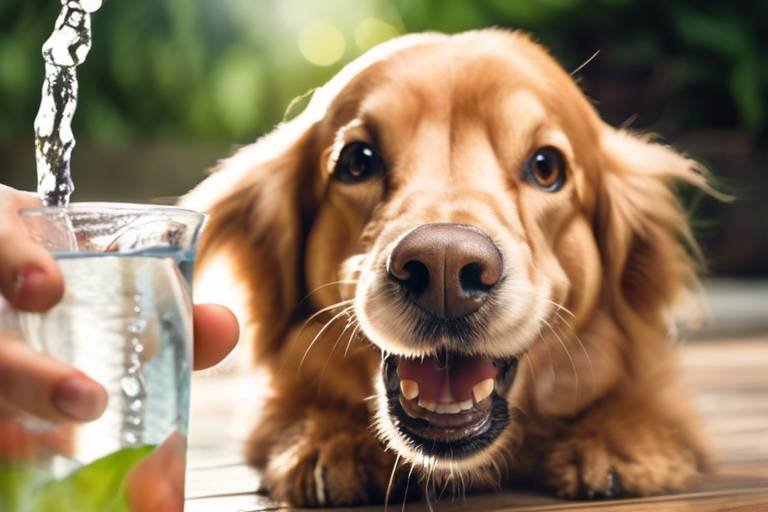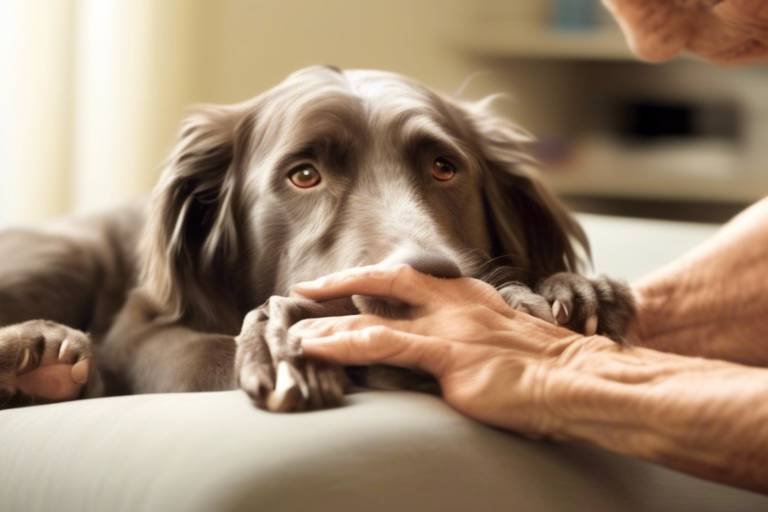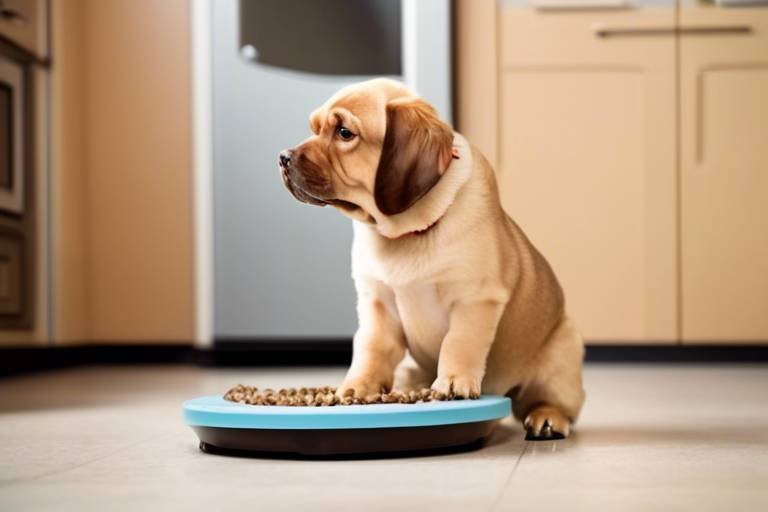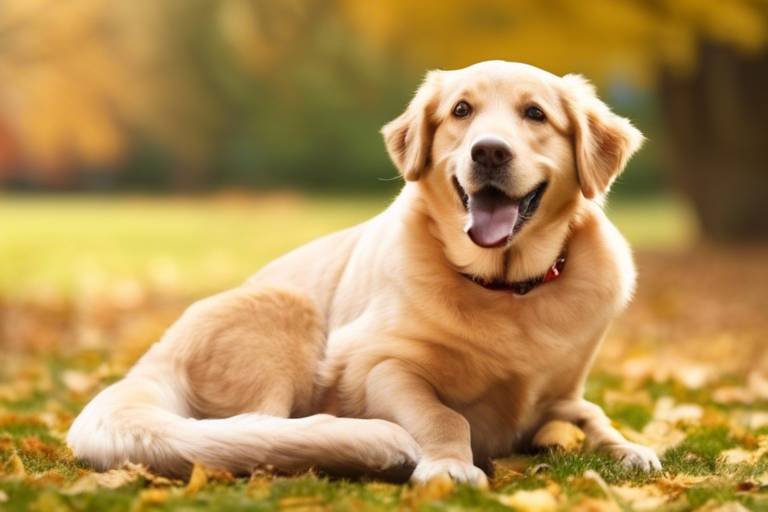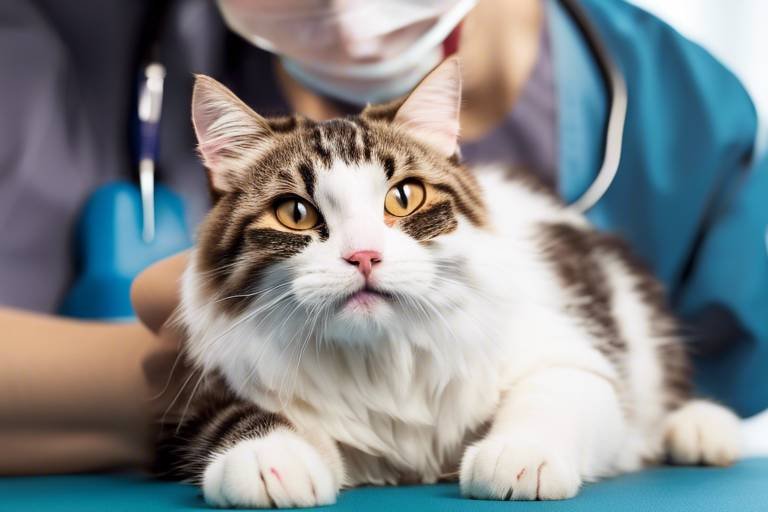How to Maintain Your Pet's Healthy Weight
Maintaining your pet's healthy weight is not just about keeping them looking good; it's about ensuring they live a long, happy, and healthy life. Just like humans, pets can suffer from a variety of health issues if they are overweight or underweight. So, how do you keep your furry friend at an ideal weight? It's a combination of balanced nutrition, regular exercise, and routine veterinary check-ups. By focusing on these areas, you can help your pet avoid the pitfalls of obesity and enjoy a vibrant life filled with energy and joy.
First and foremost, let's talk about understanding pet obesity. This is a growing concern among pet owners and veterinarians alike. Obesity in pets can lead to serious health complications such as diabetes, joint issues, and heart disease. It's essential to recognize the signs of obesity, which can include difficulty in movement, excessive panting, and a noticeable lack of energy. Understanding these signs can help you take action before it becomes a bigger problem.
Next, the cornerstone of maintaining a healthy weight is balanced nutrition. Just like us, pets require a well-rounded diet to thrive. This means providing them with the right mix of proteins, fats, and carbohydrates. But how do you know what’s best for your pet? It’s all about doing your research and choosing high-quality food that meets their specific needs. Don’t hesitate to consult your veterinarian for recommendations tailored to your pet’s breed, age, and activity level.
One critical aspect of nutrition is portion control. Overfeeding is a common mistake many pet owners make, often out of love. To prevent this, you should measure your pet’s food according to their caloric needs. For instance, if your dog requires 500 calories a day, make sure you’re not giving them 700 just because they beg for more. A simple way to manage this is by using a measuring cup or a kitchen scale. This way, you ensure they’re getting the right amount without the extra calories that lead to weight gain.
Another important factor is reading food labels. Understanding what goes into your pet’s food can help you make informed choices. Look for quality ingredients and avoid fillers that offer little nutritional value. For example, a good pet food label should list a high-quality protein source as the first ingredient, followed by whole grains and vegetables. This ensures your pet gets the nutrients they need without unnecessary additives.
If you’re feeling adventurous, consider homemade pet meals. Preparing meals at home can be a nutritious alternative to store-bought food. You can control the ingredients and tailor meals to suit your pet’s needs. Just be sure to consult with your vet to ensure you’re providing a balanced diet. There are plenty of recipes available online, ranging from simple chicken and rice to more complex meals that include vegetables and healthy fats.
Now, let’s not forget about regular exercise routines. Exercise is as vital for pets as it is for humans. It helps maintain a healthy weight, improves mood, and strengthens the bond between you and your pet. Depending on your pet's breed and age, they may require different amounts of exercise. For example, a young Labrador might need an hour of vigorous playtime, while an older cat may be satisfied with a few short play sessions throughout the day. The key is to find activities that both you and your pet enjoy.
Monitoring your pet’s weight is crucial for early detection of weight issues. Regular weigh-ins can help you catch any changes before they become a significant problem. One effective method is to use a weight chart. This visual tool can provide a quick reference for your pet's ideal weight and help you track their progress over time. You can create a simple chart at home or find printable versions online to keep track of your pet’s weight fluctuations.
Lastly, don’t underestimate the importance of veterinary check-ups. Regular visits to the vet are essential for assessing your pet’s overall health and weight. Your veterinarian can provide valuable insights into your pet’s diet and exercise needs, helping you develop a tailored plan for maintaining their ideal weight. Plus, they can catch any potential health issues early, ensuring your pet stays healthy and happy.
- How often should I weigh my pet? It's a good idea to weigh your pet at least once a month to monitor any changes.
- Can I give my pet human food? Some human foods are safe for pets, but always check with your vet before introducing new foods.
- What are the signs my pet is overweight? Look for difficulty in movement, excessive panting, and a noticeable lack of energy.
- How can I encourage my pet to exercise? Incorporate playtime into your daily routine, and try new activities to keep it fun.

Understanding Pet Obesity
This article explores effective strategies for keeping your pet at a healthy weight, including dietary considerations, exercise routines, and the importance of regular veterinary check-ups.
Pet obesity is a growing concern that can lead to serious health issues, much like how excess weight can impact humans. It’s not just about looking cute or cuddly; it’s about ensuring your furry friend lives a long, healthy life. Did you know that over 50% of pets in the United States are considered overweight or obese? This alarming statistic highlights the importance of understanding the causes and consequences of excess weight. Obesity in pets can lead to a plethora of health problems, including diabetes, joint issues, heart disease, and even certain types of cancer. The key to tackling this issue starts with recognizing what contributes to it.
So, what causes pet obesity? The primary culprits include:
- Overfeeding: Many pet owners tend to give in to those adorable puppy eyes, often leading to overfeeding.
- Inactivity: Just like us, pets need regular exercise. A sedentary lifestyle can contribute significantly to weight gain.
- High-Calorie Treats: While treats can be a great way to bond with your pet, they can also add up quickly in calories.
- Genetics: Some breeds are more prone to obesity than others, making it essential to be aware of your pet's breed-specific risks.
Understanding these factors is crucial for maintaining your pet's overall well-being. The consequences of pet obesity extend beyond just physical appearance; they can severely impact your pet’s quality of life. Imagine your beloved dog struggling to keep up during playtime or your cat unable to jump onto their favorite perch. These scenarios are heartbreaking, and they underscore the importance of proactive measures.
Additionally, it’s worth noting that pet obesity isn't just a cosmetic issue; it can also lead to emotional and psychological challenges. Overweight pets may experience lower self-esteem, which can affect their behavior and social interactions with other animals. As responsible pet owners, it’s our duty to ensure that our furry friends not only look their best but also feel their best.
In summary, understanding pet obesity is the first step toward a healthier lifestyle for your pet. By being aware of the causes and consequences, you can take proactive steps to prevent weight gain and promote a balanced, active life for your furry companion. The journey to maintaining your pet's healthy weight is a shared adventure that can strengthen your bond and enhance their quality of life.
Providing balanced nutrition is essential for your pet's health. Learn about the key components of a healthy diet and how to choose the right food for your furry friend.
Controlling portion sizes is vital in preventing overfeeding. Discover effective strategies for measuring food and understanding your pet's unique caloric needs.
Understanding pet food labels can help you make informed choices. Learn how to interpret nutritional information and identify quality ingredients in pet food.
Making homemade meals can be a healthy alternative. Explore recipes and tips for preparing balanced, nutritious meals for your pet.
Establishing a consistent exercise routine is key to maintaining your pet's weight. Find out how much exercise your pet needs and fun ways to keep them active.
Regularly monitoring your pet's weight is crucial for early detection of weight issues. Learn effective methods for tracking weight changes and evaluating your pet's body condition.
A weight chart can provide a visual reference for your pet's ideal weight. Discover how to use this tool effectively to monitor your pet's progress.
Routine veterinary visits are essential for assessing your pet's health and weight. Understand the importance of professional guidance in maintaining your pet's ideal weight.
Q: How can I tell if my pet is overweight?
A: You can check by feeling your pet's ribs; they should be easily felt but not visible. Additionally, look for a defined waist when viewed from above.
Q: What are some healthy treat alternatives?
A: Consider fruits like apples or carrots, or specially formulated low-calorie pet treats.
Q: How much exercise does my pet need?
A: Generally, dogs need at least 30 minutes to 2 hours of exercise daily, depending on the breed, while cats benefit from shorter play sessions throughout the day.
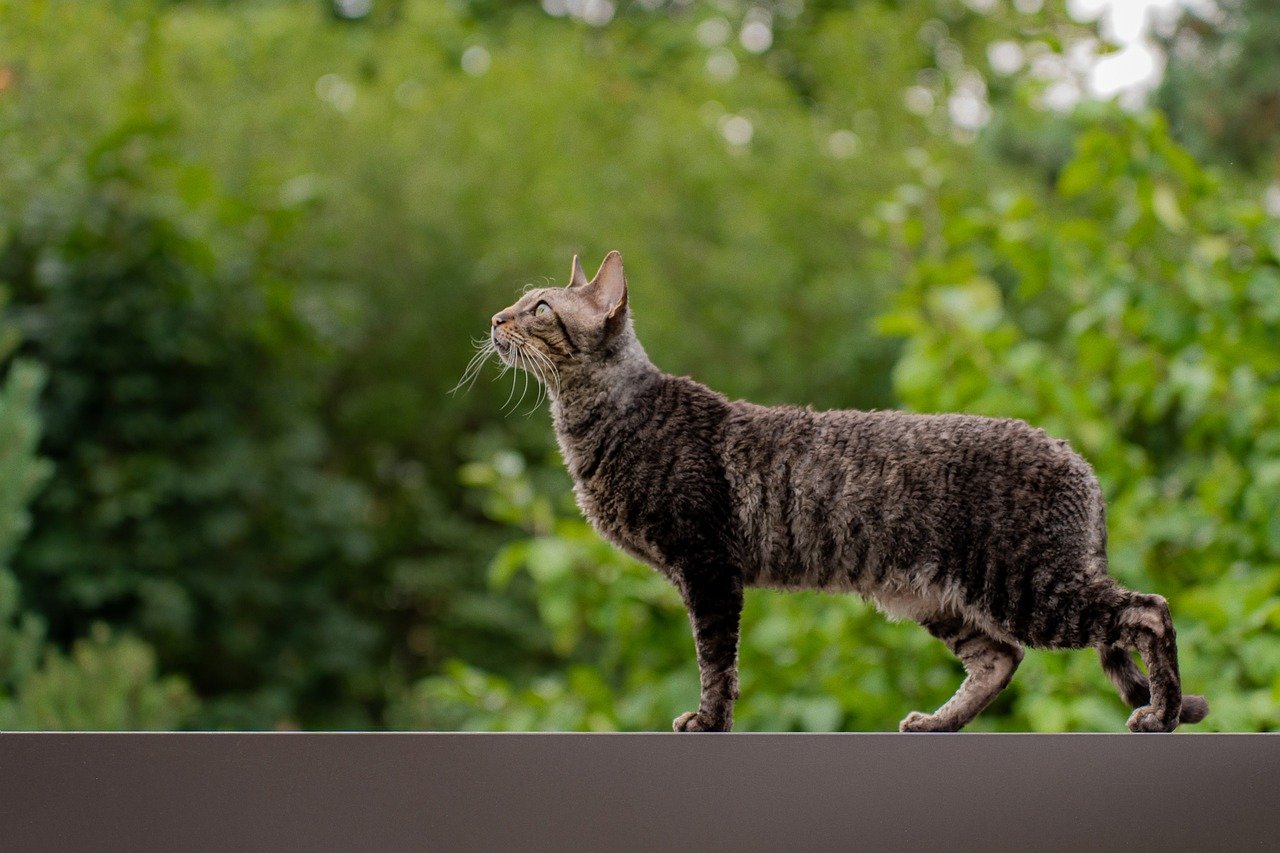
Balanced Nutrition for Pets
Providing balanced nutrition is essential for your pet's health. Just like humans, pets require a mix of nutrients to thrive, and understanding what makes up a healthy diet can be the difference between a lively, happy pet and one that faces health challenges. So, what does a well-balanced diet for pets look like? It’s not just about filling their bowl with food; it’s about offering a variety of nutrients that support their overall well-being.
At the core of your pet's diet should be high-quality protein, which is crucial for muscle development and maintenance. Proteins can come from various sources, including meat, fish, and even some plant-based options. However, it’s important to ensure that the primary ingredient is a source of animal protein, as pets are naturally carnivorous. In addition to protein, pets also need healthy fats for energy and to maintain a shiny coat. Omega-3 and Omega-6 fatty acids are particularly beneficial and can often be found in fish oil or flaxseed.
Carbohydrates are another vital component of your pet's diet. They provide energy and aid in digestion. However, not all carbs are created equal. Whole grains, vegetables, and fruits are excellent sources of carbohydrates that also offer essential vitamins and minerals. When selecting a diet for your furry friend, look for foods that include these wholesome ingredients rather than fillers like corn or soy.
To help you better understand the essential components of your pet's diet, here’s a quick overview:
| Nutrient | Function | Sources |
|---|---|---|
| Protein | Muscle development and maintenance | Meat, fish, eggs |
| Fats | Energy and healthy skin/coat | Fish oil, chicken fat, flaxseed |
| Carbohydrates | Energy and digestive health | Whole grains, vegetables, fruits |
| Vitamins & Minerals | Overall health and immune function | Supplemented in balanced diets |
When it comes to choosing the right food for your furry friend, it’s crucial to read food labels carefully. Look for products that list a specific protein source as the first ingredient and avoid those with vague terms like "meat by-products." Also, consider your pet's age, size, and activity level when selecting food, as these factors influence their nutritional needs.
Another option that many pet owners are exploring is homemade pet meals. Cooking for your pet can be a rewarding experience, allowing you to control the ingredients and ensure a balanced diet. However, it’s essential to consult with a veterinarian or a pet nutritionist to ensure that your homemade meals meet all of your pet's dietary requirements.
In summary, maintaining a balanced diet for your pet involves understanding their unique nutritional needs and making informed choices about their food. By providing a variety of high-quality ingredients, you can help your pet lead a healthier, happier life.
- What should I look for in pet food? Look for high-quality protein sources, whole grains, and avoid fillers like corn and soy.
- Can I feed my pet homemade meals? Yes, but consult with a veterinarian to ensure it meets their nutritional needs.
- How do I know if my pet is at a healthy weight? Regularly monitor their weight and consult your vet for guidance.
Portion Control
When it comes to keeping your pet at a healthy weight, is one of the most important factors to consider. Just like us, pets can easily overeat, especially when they see their food bowl filled to the brim. Imagine if you had a buffet every day—wouldn't it be tempting to indulge? That's how our furry friends feel, too! To avoid the pitfalls of overfeeding, it's crucial to understand how much food your pet really needs.
First, you need to know your pet's caloric needs. This varies based on factors such as age, size, breed, and activity level. For instance, a playful puppy will require more calories than a senior dog that prefers lounging around. A good rule of thumb is to consult your veterinarian, who can provide a tailored feeding plan based on your pet's specific needs. However, you can also use general guidelines available on pet food packaging, which often include feeding recommendations based on weight.
To help you keep track, consider using a measuring cup or a kitchen scale to portion out your pet's meals. This not only ensures you're feeding the right amount but also helps you avoid the temptation to "eyeball" it, which can lead to unintentional overfeeding. If you're unsure about the right portion sizes, here's a simple formula for calculating your pet's daily caloric needs:
| Pet Weight (lbs) | Calories per Day |
|---|---|
| 5 | 200 |
| 10 | 400 |
| 20 | 800 |
| 40 | 1600 |
Additionally, consider dividing your pet's daily food intake into multiple smaller meals throughout the day. This can help prevent hunger pangs and reduce the urge to beg for food. For instance, if your pet's daily allowance is 400 calories, you could split this into two meals of 200 calories each or even four meals of 100 calories. Not only does this approach keep your pet satisfied, but it also aids in digestion.
Lastly, don't forget to take into account any treats you might give your pet. Treats can quickly add up in calories, so it's wise to factor them into your pet's daily caloric intake. A good strategy is to reserve treats for training sessions or special occasions, ensuring they don't become a regular part of your pet's diet. Remember, treats should never exceed 10% of your pet's total daily caloric intake!
In conclusion, portion control is a straightforward yet powerful strategy for maintaining your pet's healthy weight. By measuring food, understanding caloric needs, and being mindful of treats, you can help your furry friend live a longer, healthier life. After all, a happy pet is a healthy pet!
- How do I know if I'm overfeeding my pet? Look for signs like weight gain, lethargy, or difficulty in movement. Regular weigh-ins can help track any changes.
- Can I free-feed my pet? Free-feeding is not recommended for most pets, as it can lead to overeating. Controlled portioning is generally better for weight management.
- What if my pet seems hungry even after eating? It’s natural for pets to beg for food. Ensure they’re getting enough nutrients and consider increasing the number of meals instead of the portion size.
Reading Food Labels
When it comes to your pet's health, understanding food labels is like having a treasure map that leads you to the best nutrition for your furry friend. Just as you wouldn’t want to eat junk food all the time, your pet deserves a diet that’s both nutritious and balanced. But how do you decode those tiny letters and complicated terms? Let’s break it down!
First off, always start with the ingredient list. Ingredients are usually listed in descending order by weight, which means the first few items are the most significant. If you see a high-quality protein source, like chicken or beef, at the top of the list, that’s a good sign. However, if you find fillers like corn or soy taking the lead, you might want to reconsider. Your pet should be getting their protein from real meat rather than by-products or fillers.
Next, pay attention to the guaranteed analysis. This section tells you the minimum percentages of protein and fat, as well as the maximum percentages of fiber and moisture. While it’s tempting to just glance over it, take a moment to compare these values to what’s recommended for your pet’s specific needs. For instance, a growing puppy has different nutritional requirements compared to an older dog. Understanding these numbers can help you choose the best food that aligns with your pet's lifestyle and health.
Additionally, look for any additives or preservatives in the ingredients list. While some preservatives are necessary to keep food fresh, others can be harmful in the long run. Natural preservatives like mixed tocopherols (vitamin E) are preferable over synthetic ones such as BHA or BHT. Always opt for foods that prioritize your pet’s health by using wholesome ingredients.
Lastly, don’t forget to check for any feeding guidelines provided on the packaging. These guidelines can help you understand how much food your pet should be eating based on their weight and activity level. However, remember that these are just recommendations; every pet is unique, and their needs may vary. It’s essential to adjust portion sizes based on your pet's specific requirements, which might include factors like age, breed, and health conditions.
In summary, reading food labels is an invaluable skill for any pet owner. By paying attention to the ingredient list, guaranteed analysis, additives, and feeding guidelines, you can make informed decisions that contribute to your pet's overall health and well-being. So next time you’re at the pet store, take a moment to look closely at those labels — your pet will thank you for it!
- How can I tell if my pet is overweight? Look for signs such as difficulty in feeling their ribs, a lack of a defined waist, or lethargy. Regular vet check-ups can also provide insights.
- What are some healthy treats for my pet? Consider fruits like apples or carrots, or look for commercially available treats that have high-quality ingredients.
- How often should I feed my pet? This depends on their age, size, and activity level, but most adult pets do well with two meals a day.
Homemade Pet Meals
Making homemade meals for your pet can be a fantastic way to ensure they are getting the right nutrients while avoiding the fillers and preservatives often found in commercial pet foods. Just like us, our furry friends thrive on a balanced diet that includes a variety of fresh ingredients. But how do you get started? It’s simpler than you might think! First, it’s essential to understand what constitutes a balanced diet for pets. This generally includes a mix of proteins, carbohydrates, fats, vitamins, and minerals.
When crafting homemade meals, consider incorporating ingredients like:
- Lean meats (chicken, turkey, beef)
- Vegetables (carrots, peas, sweet potatoes)
- Whole grains (brown rice, quinoa)
- Healthy fats (fish oil, flaxseed oil)
It’s important to avoid certain foods that can be harmful to pets, such as onions, garlic, chocolate, and grapes. Always consult your veterinarian before making significant changes to your pet's diet. They can help you determine the right proportions and ensure that your meals meet your pet's specific dietary needs.
One popular recipe for homemade dog food is a simple chicken and rice dish. Here’s a quick overview:
| Ingredient | Amount |
|---|---|
| Chicken breast (boneless, skinless) | 2 cups |
| Brown rice | 1 cup |
| Carrots (chopped) | 1 cup |
| Peas (fresh or frozen) | 1 cup |
| Olive oil | 1 tablespoon |
To prepare this meal, cook the chicken thoroughly, then chop it into small pieces. Cook the brown rice according to package instructions. In a separate pot, steam or boil the carrots and peas until tender. Finally, mix all the ingredients together, adding a splash of olive oil for healthy fats. Voila! You’ve just created a nutritious meal that your pet will love!
Remember, variety is key! Just like humans, pets can get bored with the same meals day in and day out. Experiment with different proteins and vegetables to keep their meals exciting. You might even find that your pet is more enthusiastic about mealtime when they see you preparing something fresh and delicious.
In conclusion, homemade meals can be a rewarding way to bond with your pet while ensuring they receive the nutrition they need. Just be sure to do your research, consult with your veterinarian, and keep your furry friend’s preferences in mind. After all, a happy pet is a healthy pet!
Regular Exercise Routines
Just like us, our furry companions need a good dose of exercise to stay healthy and happy. Establishing a consistent exercise routine is not just a good idea; it's essential for maintaining your pet's weight and overall well-being. Think of it as a fun bonding experience that benefits both of you! Whether you have a playful pup or a curious cat, incorporating regular activity into their day can be a game changer.
First off, let’s talk about how much exercise your pet actually needs. The amount can vary significantly based on factors like age, breed, and energy level. For instance, a high-energy breed like a Border Collie may require at least 1-2 hours of vigorous activity daily, while a more laid-back breed might be satisfied with just 30 minutes of leisurely walks. To help you gauge your pet's requirements, consider the following:
| Pet Type | Recommended Exercise Duration | Activity Suggestions |
|---|---|---|
| Dog (High Energy) | 1-2 hours | Running, Fetch, Agility Training |
| Dog (Medium Energy) | 30-60 minutes | Walking, Hiking, Swimming |
| Dog (Low Energy) | 15-30 minutes | Leisurely Walks, Playtime |
| Cat | 15-30 minutes | Interactive Play, Climbing, Chasing Toys |
Now, how do we keep our pets engaged and excited about exercise? Here are a few ideas to spice up their routine:
- Diverse Activities: Mix up the types of exercise you do together. Dogs love to play fetch, but they also enjoy tug-of-war, swimming, and even some agility training. Cats can benefit from climbing structures, laser pointers, or feather wands to keep them active.
- Socialization: Consider taking your dog to a dog park or joining a local pet group. Socializing with other pets can make exercise feel like playtime!
- Routine: Just like kids thrive on routine, pets do too! Try to set specific times for walks or play sessions, so they know what to expect.
Don’t forget to monitor your pet during exercise. Watch for signs of fatigue, especially on hot days. Hydration is crucial, so always have fresh water available. If your pet is panting heavily or seems reluctant to continue, it’s time to take a break. Remember, the goal is to have fun while keeping them healthy!
Incorporating regular exercise into your pet's life doesn’t have to be a chore. Think of it as an adventure waiting to unfold. You both can explore new parks, discover hidden trails, or even try out dog-friendly beaches. This not only helps in maintaining a healthy weight but also strengthens your bond, making every moment together worthwhile.
Q: How do I know if my pet is overweight?
A: You can check your pet’s weight against breed standards, feel for their ribs (they should be easily felt), and observe their waistline when viewed from above.
Q: What if my pet doesn’t like to exercise?
A: Start slow! Try short play sessions with toys they enjoy, and gradually increase the duration as they get more comfortable with activity.
Q: Are there specific exercises for older pets?
A: Yes! Older pets may benefit from gentler activities like short walks, swimming, or light play to keep their joints healthy without overexertion.

Monitoring Your Pet's Weight
Keeping an eye on your pet's weight is not just a good idea; it's essential for their overall health and happiness. Just like us, pets can struggle with weight issues, and being overweight can lead to a range of health problems, from diabetes to joint issues. So, how do you stay on top of your furry friend's weight? It all comes down to a few simple strategies that can make a big difference.
First, it's important to establish a baseline weight for your pet. This is their ideal weight, which you can determine by consulting with your veterinarian. They can help you understand what a healthy weight looks like for your specific breed and size. Once you have this baseline, you can start monitoring your pet's weight on a regular basis.
One effective method for tracking your pet's weight is by using a weight chart. This chart can serve as a visual reference to help you see how your pet's weight fluctuates over time. You can create a simple chart on paper or use an app designed for pet care. Just be sure to record their weight consistently, ideally at the same time each week or month. This way, you can easily spot any trends—whether they’re gaining or losing weight.
| Weight Monitoring Schedule | Frequency |
|---|---|
| Under 1 Year Old | Every 2 weeks |
| 1-5 Years Old | Monthly |
| Over 5 Years Old | Every 2 months |
In addition to tracking their weight, you should also evaluate your pet's body condition regularly. This involves looking at their overall shape and feeling their ribs. A pet in good shape should have a defined waist and should be able to feel their ribs without excessive fat covering. If your pet is starting to look more like a couch potato than a playful pup, it might be time to reassess their diet and exercise routine.
And don't forget about the importance of veterinary check-ups. Regular visits to the vet can provide professional insights into your pet's weight and health. Your vet can recommend specific diets, exercise plans, and even supplements if needed. They can also help identify any underlying health issues that may be contributing to weight gain or loss. Think of your vet as your pet's personal trainer, guiding you both on the path to a healthy lifestyle.
- How often should I weigh my pet? It depends on their age and health status. Generally, younger pets should be weighed more frequently than older ones.
- What should I do if my pet is overweight? Consult your veterinarian for a tailored diet and exercise plan that suits your pet’s needs.
- Are there any specific breeds prone to obesity? Yes, certain breeds like Labrador Retrievers and Bulldogs are more prone to weight issues, so extra vigilance is necessary.
Using a Weight Chart
Using a weight chart is an effective way to keep track of your pet’s weight and ensure they are maintaining a healthy size. Think of it as a roadmap for your pet’s health journey; it helps you visualize where they are and where they need to be. A weight chart typically includes the ideal weight range for different breeds and sizes, making it easier for you to assess your pet's condition at a glance. It's important to note that just like humans, pets come in all shapes and sizes, so understanding what is considered a healthy weight for your particular furry friend is crucial.
To effectively utilize a weight chart, start by finding a reliable source that provides the ideal weight ranges for various breeds. Many veterinary websites and pet care organizations offer these charts. Once you have this information, you can regularly weigh your pet—ideally once a month—and plot their weight on the chart. This visual representation can help you quickly identify any significant changes that may require attention.
For example, if you notice that your pet's weight is creeping up towards the upper limit of their ideal range, it might be time to reassess their diet and exercise routine. Conversely, if they are consistently below the ideal weight, it could indicate that they need more nutrition or a health check-up. A weight chart not only aids in monitoring your pet’s weight but also serves as a conversation starter during veterinary visits, ensuring you and your vet are on the same page regarding your pet's health.
Here’s a simple example of what a weight chart might look like for a medium-sized dog:
| Breed | Ideal Weight Range (lbs) |
|---|---|
| Beagle | 20 - 30 |
| Cocker Spaniel | 25 - 35 |
| Bulldog | 40 - 50 |
Incorporating a weight chart into your pet care routine can make a world of difference. It’s not just about keeping your pet looking good; it’s about ensuring they live a long, healthy life. Remember, maintaining a healthy weight can prevent a myriad of health issues, such as diabetes, joint problems, and heart disease. So, don’t underestimate the power of a simple chart—it can be your best ally in the quest for your pet’s optimal health!
- How often should I weigh my pet? It's recommended to weigh your pet once a month to track any changes effectively.
- What should I do if my pet is overweight? Consult your veterinarian for a tailored diet and exercise plan.
- Can I use a human scale to weigh my pet? Yes, but make sure to weigh yourself first, then weigh yourself while holding your pet and subtract the difference.
- Are weight charts the same for all breeds? No, different breeds have different ideal weight ranges, so always refer to breed-specific charts.
Veterinary Check-ups
When it comes to maintaining your pet's healthy weight, are like a compass guiding you through the sometimes murky waters of pet health. These visits are not just routine; they are essential for catching potential weight issues before they snowball into serious health problems. Just like we visit our doctors for regular health assessments, our furry companions need the same level of attention and care.
During these check-ups, your veterinarian will perform a thorough examination, which includes weighing your pet and evaluating their body condition score (BCS). The BCS is a system that helps determine whether your pet is underweight, at a healthy weight, or overweight. This assessment is crucial because it provides a clear picture of your pet's overall health and helps tailor a weight management plan that suits their specific needs.
But what should you expect during a veterinary visit? Here’s a quick rundown:
- Weight Measurement: Your vet will weigh your pet and compare it to their ideal weight range.
- Body Condition Scoring: This involves visually and physically assessing your pet's body to determine their fat coverage.
- Dietary Recommendations: Based on the findings, your vet may suggest dietary changes or specific food brands that can help your pet lose or maintain weight.
- Exercise Advice: Your vet can provide tailored exercise recommendations based on your pet's age, breed, and current health status.
Furthermore, these visits are an excellent opportunity to discuss any behavioral changes you've noticed in your pet. Have they become more lethargic? Are they eating more or less than usual? Such changes can be indicative of underlying health issues that need to be addressed. It's always better to be proactive rather than reactive when it comes to your pet's health.
In addition to the physical examination, your veterinarian may recommend some diagnostic tests such as blood work or urine analysis to rule out any metabolic disorders. These tests can provide invaluable insights into your pet's health, ensuring that their weight issues are not merely symptoms of a more severe condition.
Now, you might be asking yourself, "How often should I take my pet for check-ups?" Generally, it's advisable to visit the vet at least once a year, but if your pet is overweight or has existing health issues, more frequent visits may be necessary. Think of it as a wellness check—the more you know, the better equipped you are to make informed decisions about your pet’s health.
In conclusion, regular veterinary check-ups are a fundamental part of maintaining your pet's healthy weight. They provide a wealth of information and support that can help you navigate the complexities of pet health. So, don’t skip those appointments—your pet’s health and happiness depend on it!
Q: How often should I take my pet to the vet for weight checks?
A: It's recommended to take your pet for a check-up at least once a year, but more frequent visits may be necessary for overweight pets or those with health issues.
Q: What is a body condition score (BCS)?
A: BCS is a system used by veterinarians to assess your pet's body fat and overall health, helping to determine if they are underweight, at a healthy weight, or overweight.
Q: Can my vet help with a weight loss plan for my pet?
A: Absolutely! Your veterinarian can provide tailored dietary and exercise recommendations based on your pet's specific needs.
Q: What should I do if my pet is overweight?
A: Consult your veterinarian for a comprehensive assessment and personalized weight management plan that includes diet and exercise modifications.
Frequently Asked Questions
- What are the main causes of pet obesity?
Pet obesity can stem from a variety of factors, including overfeeding, lack of exercise, and certain medical conditions. Just like us, pets can gain weight if they consume more calories than they burn. It's essential to monitor their diet and activity levels closely to prevent this from happening.
- How can I determine the right portion size for my pet?
Determining the right portion size involves understanding your pet's ideal weight, age, and activity level. Most pet food packages provide guidelines based on weight, but it’s a good idea to consult your veterinarian for personalized advice. Think of it like adjusting a recipe; you want to find the perfect balance that keeps your pet healthy and happy!
- Are homemade meals better for my pet?
Homemade meals can be a great alternative as long as they are balanced and nutritious. However, it's crucial to ensure that they meet your pet's dietary needs. Consulting with a vet or a pet nutritionist can help you craft meals that are safe and beneficial. It's like cooking for a friend—you want to make sure they get all the right ingredients!
- How much exercise does my pet need?
The amount of exercise your pet needs can vary based on their breed, age, and health. Generally, dogs require at least 30 minutes to 2 hours of exercise daily, while cats benefit from shorter, more frequent play sessions. Think of exercise as a fun game; it’s not just about burning calories but also about bonding with your furry friend!
- What should I do if my pet is overweight?
If you suspect your pet is overweight, the first step is to consult your veterinarian. They can help you create a tailored weight loss plan that includes dietary changes and increased exercise. Remember, losing weight is a journey, and it’s important to do it safely and gradually!
- How often should I take my pet to the vet for weight checks?
Regular veterinary check-ups are essential, especially if your pet is on a weight management plan. Ideally, you should visit the vet at least once every six months, or more frequently if your pet has specific health concerns. Think of it as a routine tune-up to keep your pet in top shape!
- What are some signs that my pet is overweight?
Some common signs of pet obesity include difficulty in feeling their ribs, lack of energy, and a noticeable belly. If your pet struggles to play or seems to be panting excessively after short walks, it might be time to reassess their weight. Just like we notice when our clothes fit a little too snugly, pets can show signs when they’re carrying extra weight!








